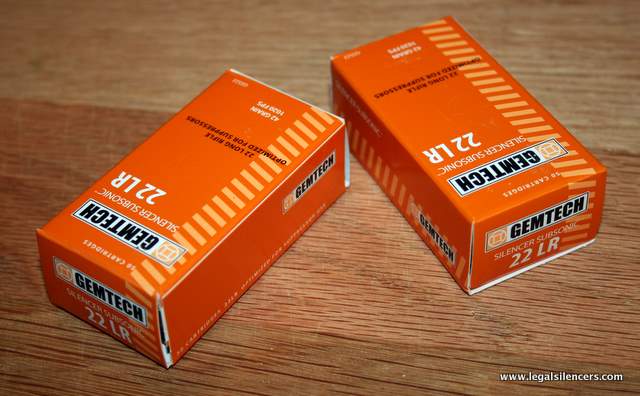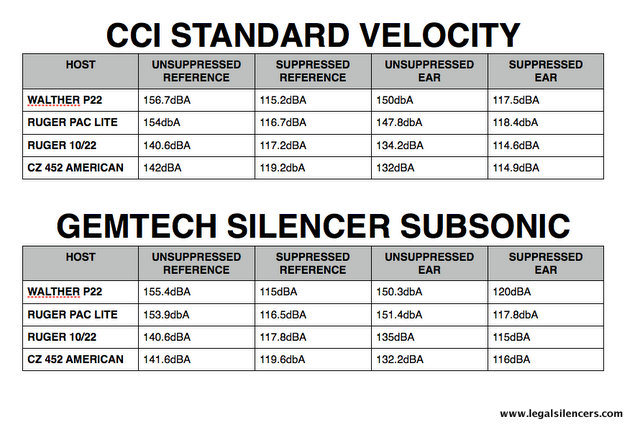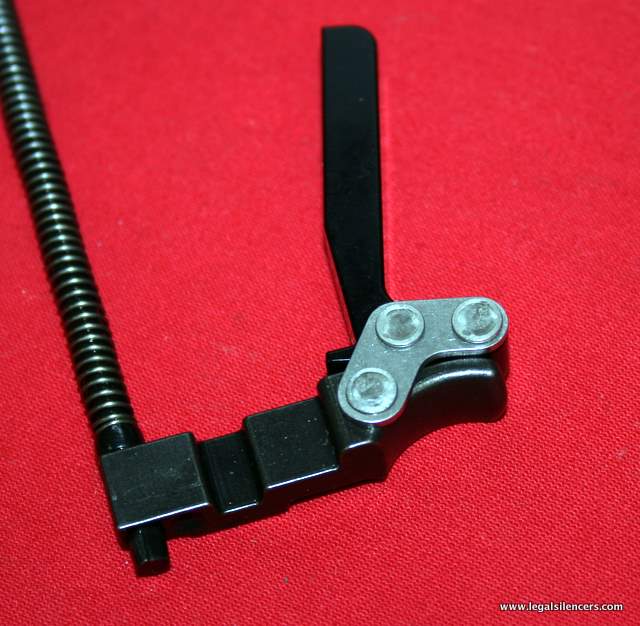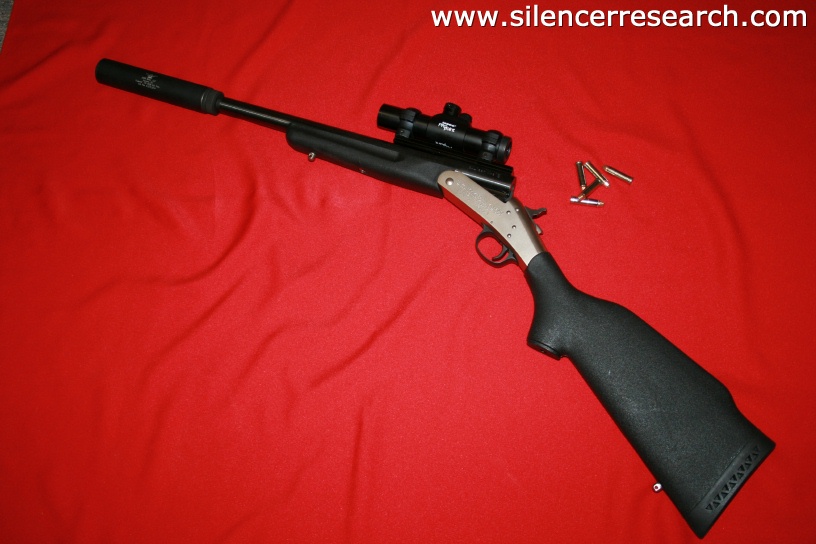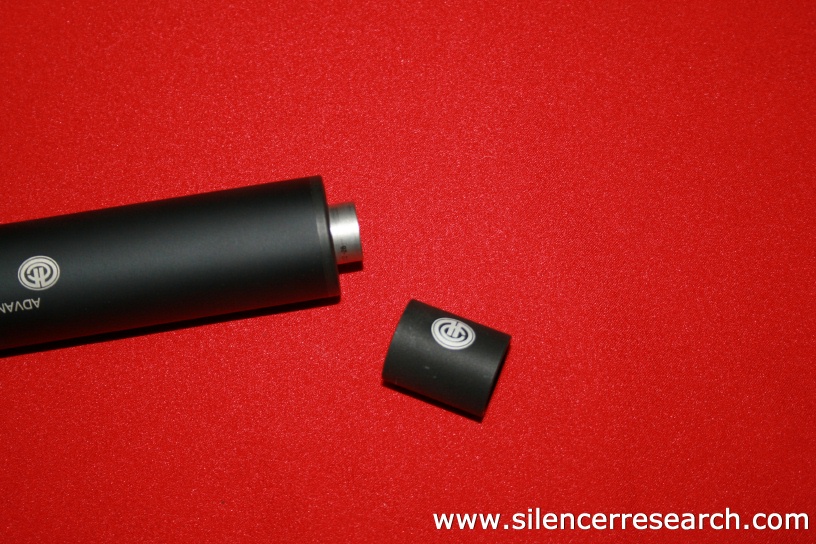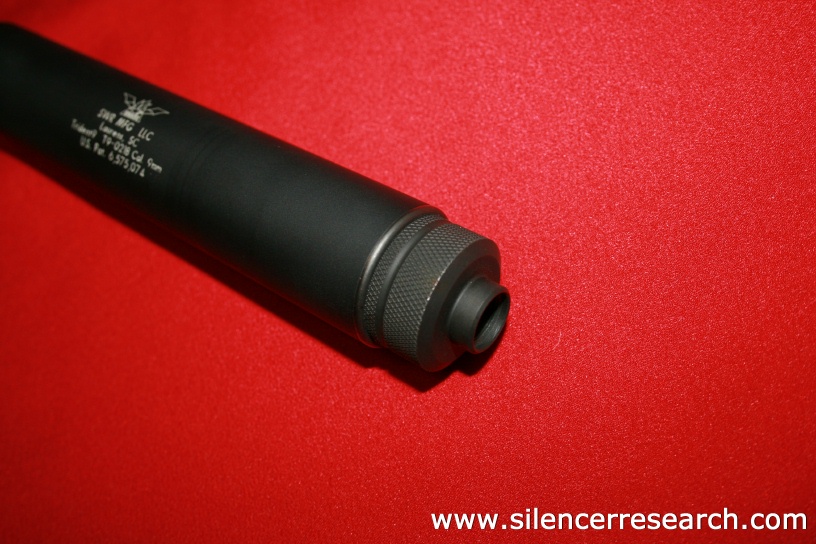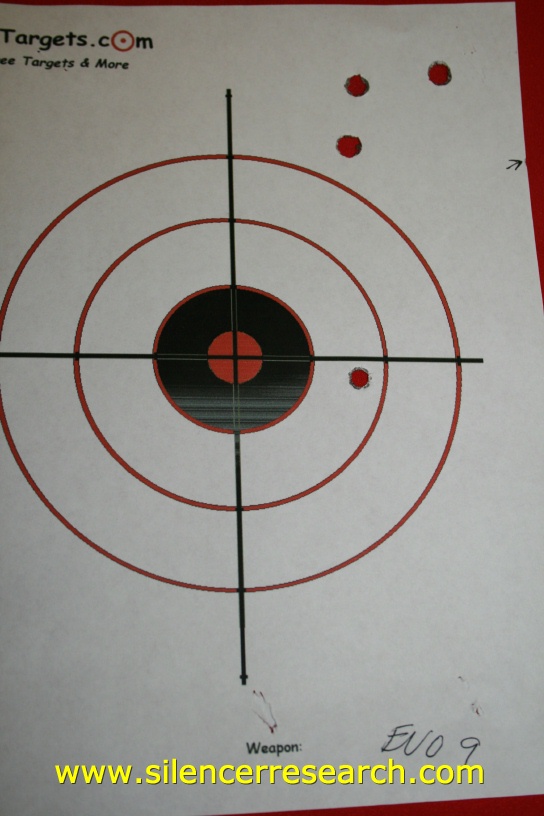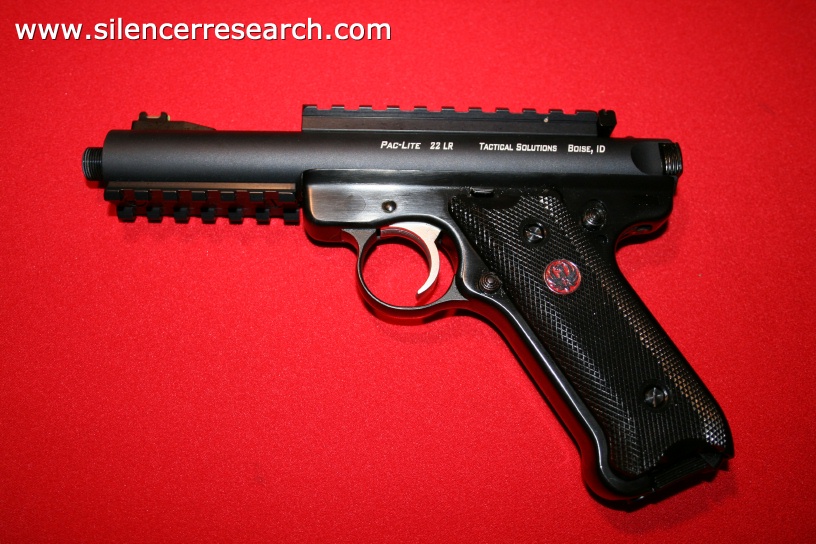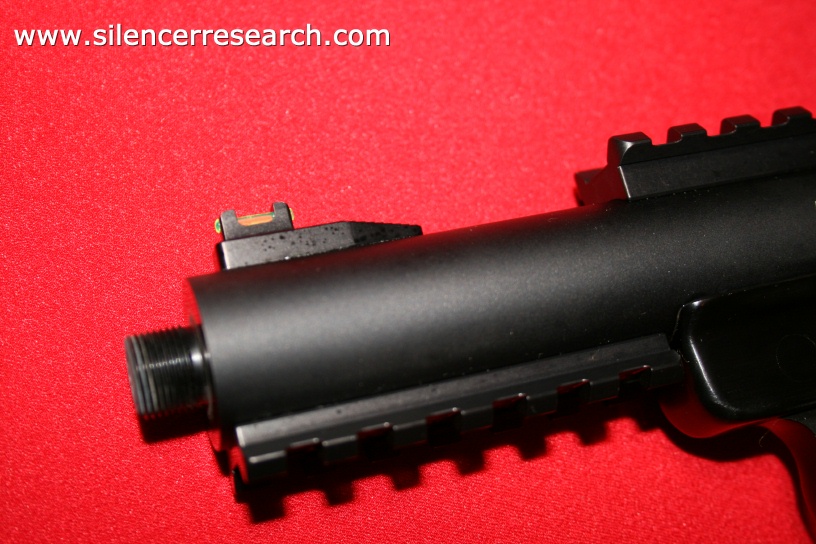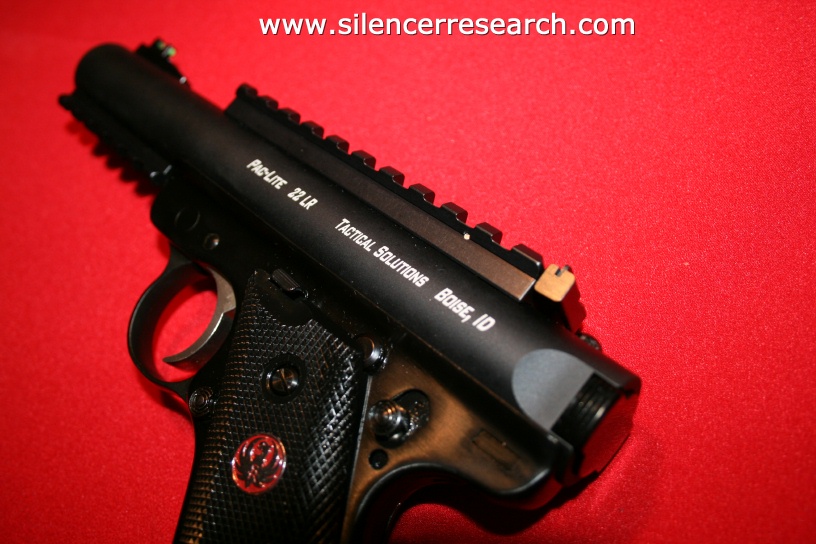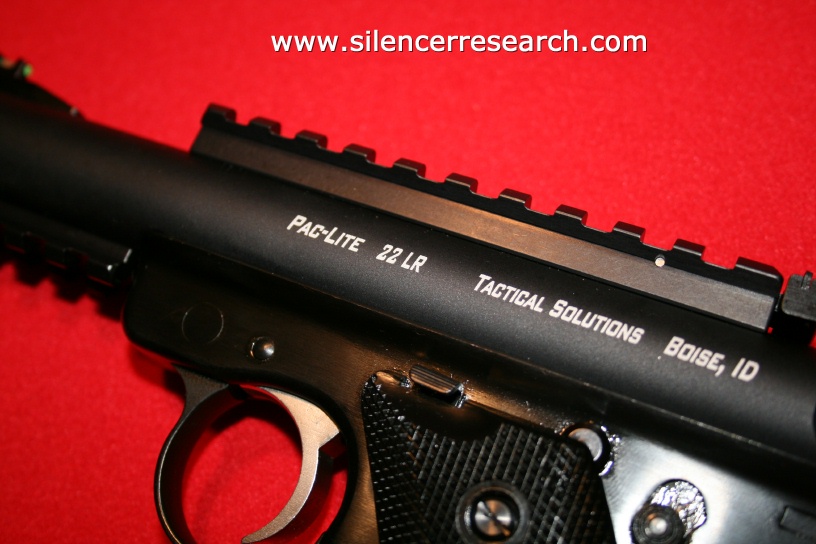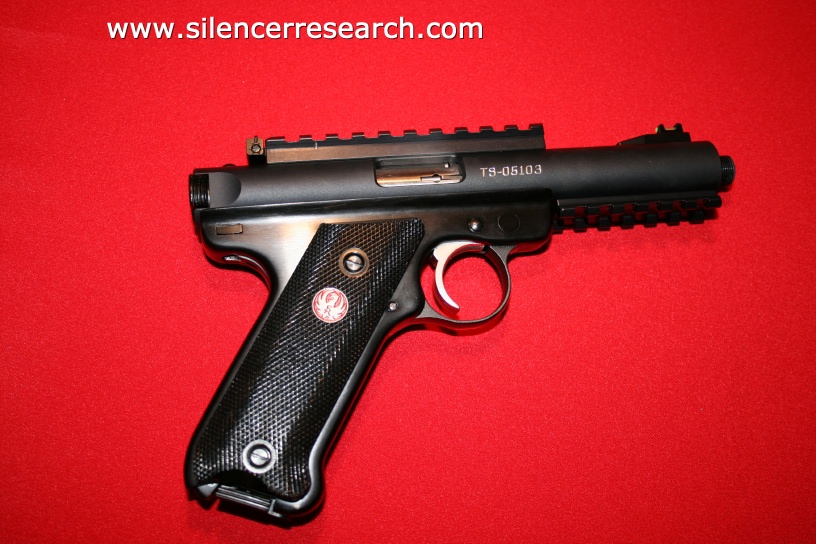John Norrell Integral 10/22 Silencer
On April 1, 2007, I did an extensive review of the Ruger 10/22 with the Norrell integral silencer. I tested 5 types of high velocity ammunition for both dB and ballistics/velocity. Here is a picture of the weapon.

Norrell Integrally suppressed 10/22 Specifications
This is a stainless steel factory 10/22 with the silencer built over the factory barrel. The weapons overall length is 38 inches with an aftermarket rubber Hogue Overmold stock. It weighs 6 pounds 8.8 ounces (with the factory plastic stock it weighs 6 pounds 4.3 ounces. The scope is a Leupold VX 1 2-7X 28 Rimfire Speical. The parallax correction is set at 60 yards so you can focus on targets much closer than a scope that is not set up for rimfire. The base and rings are Leupold as well. The crosshairs are a very fine set of crosshairs, so refined shooting is possible. The outer diameter of the Norrell silencer is right at one inch with an overall length of 18 and 15/16th. Integral silencers are different than muzzle silencers as integral silencers “live” on the weapon for life. There are advantages and disadvantages to both systems. Here is a picture of a Norrell 10/22 system disassembled into its component groups. This particular picture shows what is know as a “shorty.” This is a shorter barrel, but the concept remains the same. These shorter barrels require a registered machine gun system in the weapon or the receiver must be registered as a short barreled rifle.
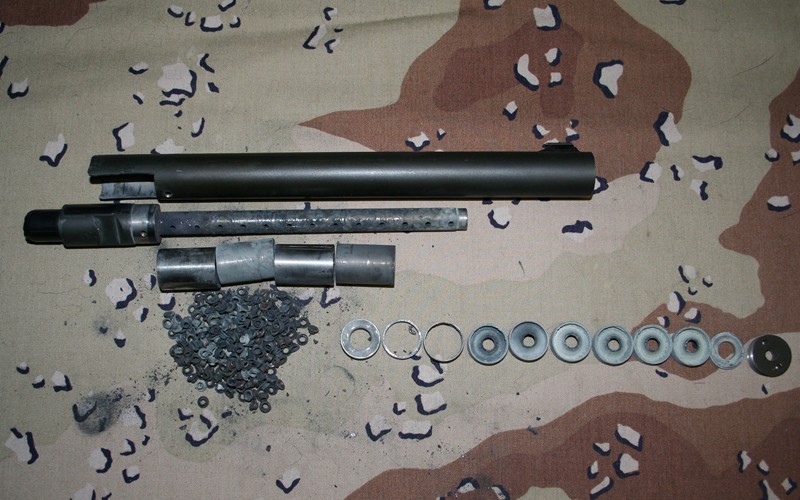
The silencer is constructed so that the powder gas does not touch the outer registered tube, instead liners are utilized to keep this mess from touching the registered portion. Holes are drilled into the barrel to bleed gas off of the exiting bullet in order to drop the velocities to below the sound barrier. High velocity 40 grain ammo is recommended by the manufacturer. This helps keep velocities up and acceptable for shooting live game as well as providing the 10/22 action and bolt enough power to work reliably without altering the factory setup. The manufacturer provides a takedown tool that the end user can purchase and use to facilitate the cleaning procedure. This tool makes cleaning the silencer much easier and does not allow the external registered tube to become damaged.
Testing Method
The tests were conducted using the B&K 2209 sound meter with a B&K 4136 microphone calibrated with the B&K 4220 Pistonphone. All equipment has been certified and tested so that it can be traced back to the N.I.S.T standards. The meter and weapon are also placed in accordance with Mil-Std 1474D protocol. The Ruger 10/22 with the Norrell integral suppressor was fitted with an Eagle 30 round magazine and 15 rounds were loaded of each ammunition type tested. Ballistics were taken by a chronograph. There is no way to test an integral upper for an unsuppressed reading.
Ammunition Tested
I tested 2 boxes of CCI Minimags (the recommended ammunition for this weapon as per the manufacturer) as well as PMC Zapper, Federal 40 grain Game Shok, and Remington “Golden Bullet” 40 grain rounds.
Norrell integrally suppressed 10/22 with CCI Minimags (Amber Box)
I have fired pretty close to 12,000 rounds of this ammunition type through this suppressor. The ammunition produces very consistent velocities and seldom causes any cycling problems. I loaded an Eagle 30 round plastic magazine with 15 rounds and fired the weapon to test for dB levels as well as the velocities. There is no way to test an integral suppressor unsuppressed, so I am unable to provide a dB reduction level. However, as cross reference, the a previous test of the unsuppressed 10/22 with CCI Minimags was 142.1dB. The average dB reading was 111.7dB and the velocities averaged 968 feet per second. The suppressed range was 110.5 to 113dB.
Norrell integrally suppressed 10/22 with CCI Minimags (Clear Box)
CCI recently changed the color of the packaging of its 22LR ammo. In doing this, I thought that perhaps the ammunition itself had changed. After several conversations with the company I was assured that no changes were made. I did experience some inconsistencies (such as ejection port bark, a larger variation if FPS, etc…) with the newer ammunition in my full auto 22 M16 Ceiner kit. If anything transpires further regarding this ammunition, I will keep everyone posted. These CCI Minimags produced an average of 111.1dB and the velocities averaged 968 feet per second. 109-113.5 was the dB range.
Norrell integrally suppressed 10/22 with PMC Zapper
PMC Zapper is not a recommended ammunition by the manufacturer, but is included for comparison testing purposes. The average dB reading was 111.2dB with the average velocities coming in at 1005 feet per second. The ammo tested well and was faster than the CCI Minimags. The dB range was 110-112dB so it was as quiet as the other ammunition types. I had one round to fly over 1050fps, and that can enter the trans-sonic danger zone at higher altitudes and in different weather conditions.
Norrell integrally suppressed 10/22 with Federal Game Shok 40 Grain
Federal Game Shok was tested in the Norrell system for comparison purposes and is not recommended in the users manual. The average db level was 111.7dB and the average velocities were 986 feet per second. The dB range was 110.5 to 113.5dB. The same parent company owns Federal AND CCI, so it’s highly probable that both the CCI and the Federal 22LR ammo are produced with much the same components. The both come in a clear box and the ammo (except for the head stamp) look identical.
Norrell integrally suppressed 10/22 with Remington “Golden Bullet” 40 Grain
This ammunition is NOT to be confused with the bulk pack ammunition sold by the 550 pack “bricks” in Wal-Mart. This is 40 grain high velocity solid point, not 36 grain hollow points. The manufacturer does not recommend using “promotional” ammunition like the 36 grain high velocity plinking ammo. It varies too much to be reliable. I have shot some of the promotional ammo and had 100-135fps variations. That is beyond the 90fps specifications that are set forth by SAMMI for 22 Long Rifle ammunition. The Remington Golden Bullet 40 grain ammo produced an average dB level of 111.8 dB and produced average velocities of 1001 feet per second.
Norrell integrally suppressed 10/22 Chart Data
|
Video
|
22LR Ammunition
|
Average Velocities FPS |
Average Suppressed dB |
|
CCI Minimag (Amber Box) 15 Shot Average |
967.9 FPS |
111.7dB |
|
CCI Minimag (Clear Box) 15 Shot Average |
968.5 FPS |
111.1dB |
|
PMC Zapper 15 Shot Average |
1005 FPS |
111.2dB |
|
Federal Game Shok 40 Grain 15 Shot Average |
985.6 FPS |
111.7dB |
|
Remington “Golden Bullet” 40 grain 15 Shot Average |
1000.9 FPS |
111.8dB |
| TOTAL |
Average of all ammunition |
985.6 FPS |
111.5dB |
I measured bolt drop on the Norrell 10/22 for comparisons sake and found that an average of 5 bolt drops on an empty chamber resulted in an average of 111.5dB. I am awaiting a 10/22 bolt lock device that holds the bolt closed mechanically. When this device arrives, I will be able to test the Norrell system without the interference of the bolt and will post those results.
EMAIL
Copyright Silencer Research LLC. No part of this article, its videos, or numbers may be posted or used elsewhere without the express written consent of the author.


